Overview
This article delves into proven strategies for achieving success in digital banking transformation, highlighting the critical need for financial institutions to integrate technology while cultivating a culture of innovation and agility. How can institutions navigate the complexities of legacy systems and regulatory compliance? By establishing a clear vision, investing in training, and leveraging partnerships, organizations can effectively overcome these challenges.
These strategies are not merely suggestions; they are essential for enhancing customer experience and operational efficiency. As a result, embracing these approaches positions financial institutions to thrive in an increasingly digital landscape. Take action now to transform your institution and reap the benefits of a forward-thinking strategy.
Introduction
In an age where technology is reshaping the financial landscape, digital banking transformation emerges as a critical imperative for banks striving to enhance customer experiences and operational efficiencies. This evolution transcends mere technological adoption; it demands a comprehensive cultural shift within organizations to foster innovation and agility. With over 60 countries embracing open banking regulations in 2023, the drive towards transparency and customer empowerment is gaining momentum. However, the journey is fraught with challenges, including:
- Legacy systems
- Cybersecurity threats
- A pressing need for skilled professionals
As banks navigate these complexities, understanding the transformative potential of digital technologies becomes essential for maintaining a competitive edge in the rapidly changing financial sector.
Understanding Digital Banking Transformation
The digital banking transformation signifies a pivotal integration of digital technology across all facets of financial operations, fundamentally reshaping how financial institutions function and deliver value to their clients. This evolution transcends mere technology adoption; it demands a cultural shift within organizations that nurtures innovation and agility. As financial institutions transition from traditional models, they must prioritize enhancing user experiences, optimizing operational efficiencies, and complying with regulatory standards.
In 2023, over 60 countries initiated open banking regulations, marking a significant development that reflects a global trend toward increased transparency and customer empowerment in financial services. This shift is critical as banks encounter considerable obstacles to technological transformation, including cyber threats, environmental, social, and governance (ESG) goals, and a scarcity of skilled professionals. Notably, 20% of IT leaders have identified unclear or unsupportive organizational leadership as a key factor contributing to transformation failures, underscoring the need for robust guidance and support from leadership.
The impact of electronic technology on banking operations is profound. For instance, online banking has been instrumental in promoting financial inclusion, particularly for underserved populations. Companies like Chime and N26 have concentrated on providing accessible banking services, resulting in an estimated 1.2 billion previously unbanked individuals entering the formal financial system by 2023.
This illustrates the transformative potential of digital banking in addressing societal needs while enhancing operational capabilities, reinforcing the critical importance of digital transformation within the banking sector.
The company is at the forefront of this transformation, offering a dedicated hybrid integration platform that simplifies the complexities of disparate systems. By unlocking isolated assets, Avato empowers financial institutions to spearhead the AI revolution, improving customer experiences and operational efficiency. Our commitment to resolving complex integration challenges is rooted in our core values of dedication and innovation, as reflected in our name, which means ‘of dedication’ in Hungarian.
Expert opinions highlight the urgency of the digital banking transformation. Michael J. Hsu, the Acting Comptroller of the Currency, remarked that some financial institutions may “feel like hostages” to their legacy technology, emphasizing the necessity for a proactive approach to modernization. This underscores the essential importance of addressing legacy systems as banks navigate this technological landscape.
Understanding the advantages of digital banking transformation—such as enhanced client engagement, operational resilience, and compliance—will be crucial for maintaining a competitive edge in 2025 and beyond.
Recent trends indicate a growing emphasis on leveraging technological advancements to improve service delivery and operational efficiency. Successful case studies in digital banking transformation demonstrate that organizations embracing these changes can achieve significant enhancements in both customer satisfaction and financial performance. As the banking industry continues to evolve, the integration of technological advancements, supported by innovative solutions from the company, will remain a vital factor for success.
Are you ready to lead your organization into the AI-powered future of finance? Connect with Avato today to explore your evolving AI needs. Our AI assessment is designed to provide you with tailored insights and strategies to elevate your business.
Let’s discover how we can help you thrive in the AI landscape!
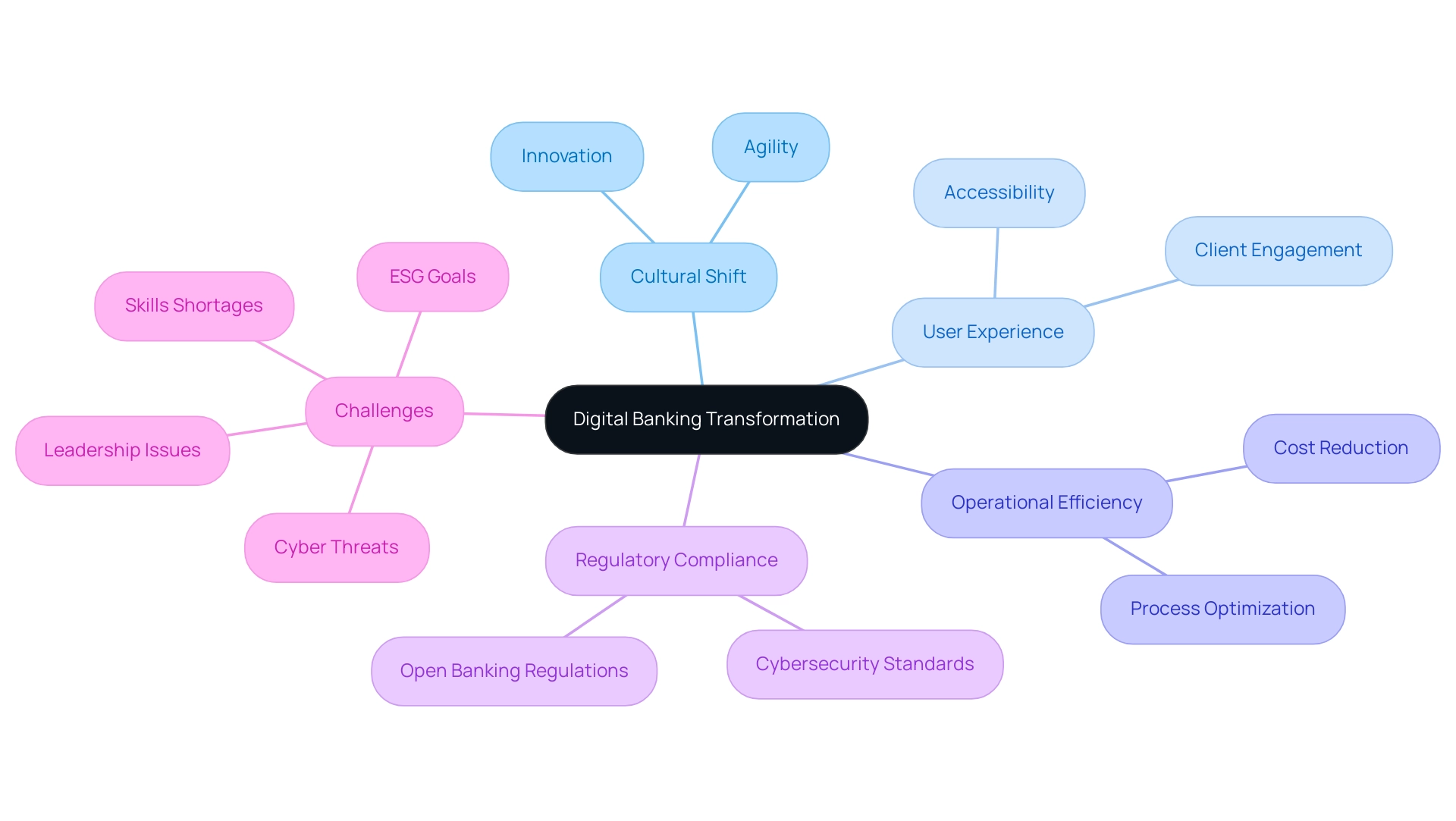
Technologies Driving Digital Transformation in Banking
Several technologies are pivotal in driving digital banking transformation, including:
-
Artificial Intelligence (AI): AI is revolutionizing customer service by utilizing chatbots and personalized recommendations, streamlining operations while enhancing decision-making processes. A recent survey indicates that 29% of banking professionals plan to implement AI and machine learning (ML) technologies in their operations, reflecting a growing recognition of AI’s potential.
Furthermore, AI is projected to save financial institutions up to $487 billion by 2024, primarily through improvements in front and middle-office operations. This significant financial benefit underscores the necessity of AI adoption in the banking sector. Additionally, a survey by Gartner reveals varying stages of AI/ML adoption within finance operations, with 30% of respondents having no plans for implementation and 29% planning to implement AI/ML technologies. These insights illustrate the transformative impact of AI on operational efficiency in finance, indicating a gradual shift towards integrating AI/ML technologies in financial institutions.
-
Blockchain: This technology is crucial for ensuring secure and transparent transactions, particularly in cross-border payments and fraud prevention. The adoption of blockchain solutions is gaining momentum, with financial institutions increasingly recognizing its ability to enhance security and efficiency in transactions.
-
Cloud Computing: By enabling scalable and flexible IT infrastructure, cloud solutions empower financial institutions to innovate rapidly while significantly reducing operational costs. The transition to cloud-based systems enables greater agility in responding to market demands and client needs.
-
Data Analytics: Advanced analytics tools are essential for banks to gain insights into client behavior, optimize services, and make informed, data-driven decisions. The integration of data analytics into banking operations is becoming a standard practice, facilitating a deeper understanding of client preferences and trends.
-
Mobile Banking Solutions: These applications offer users convenient access to banking services anytime, anywhere, thereby enhancing user experience and engagement. The growth of mobile banking is altering how clients engage with their financial organizations, rendering financial services more reachable than ever.
The incorporation of these technologies is not merely a trend but an essential factor for financial institutions striving for digital banking transformation to remain competitive in a progressively digital environment. The Hybrid Integration Platform plays a crucial role in the digital banking transformation, providing strategic integration approaches that prepare financial institutions for the upcoming open banking era. By leveraging Avato’s platform, which includes features such as secure data sharing, real-time analytics, and seamless connectivity between legacy systems and modern applications, financial institutions can ensure secure and efficient system integration, ultimately enhancing operational efficiency and customer satisfaction.
As evidenced by case studies on AI adoption in finance operations, there is a gradual yet significant shift towards embracing these innovations, with many institutions recognizing the transformative impact they can have on their operations.
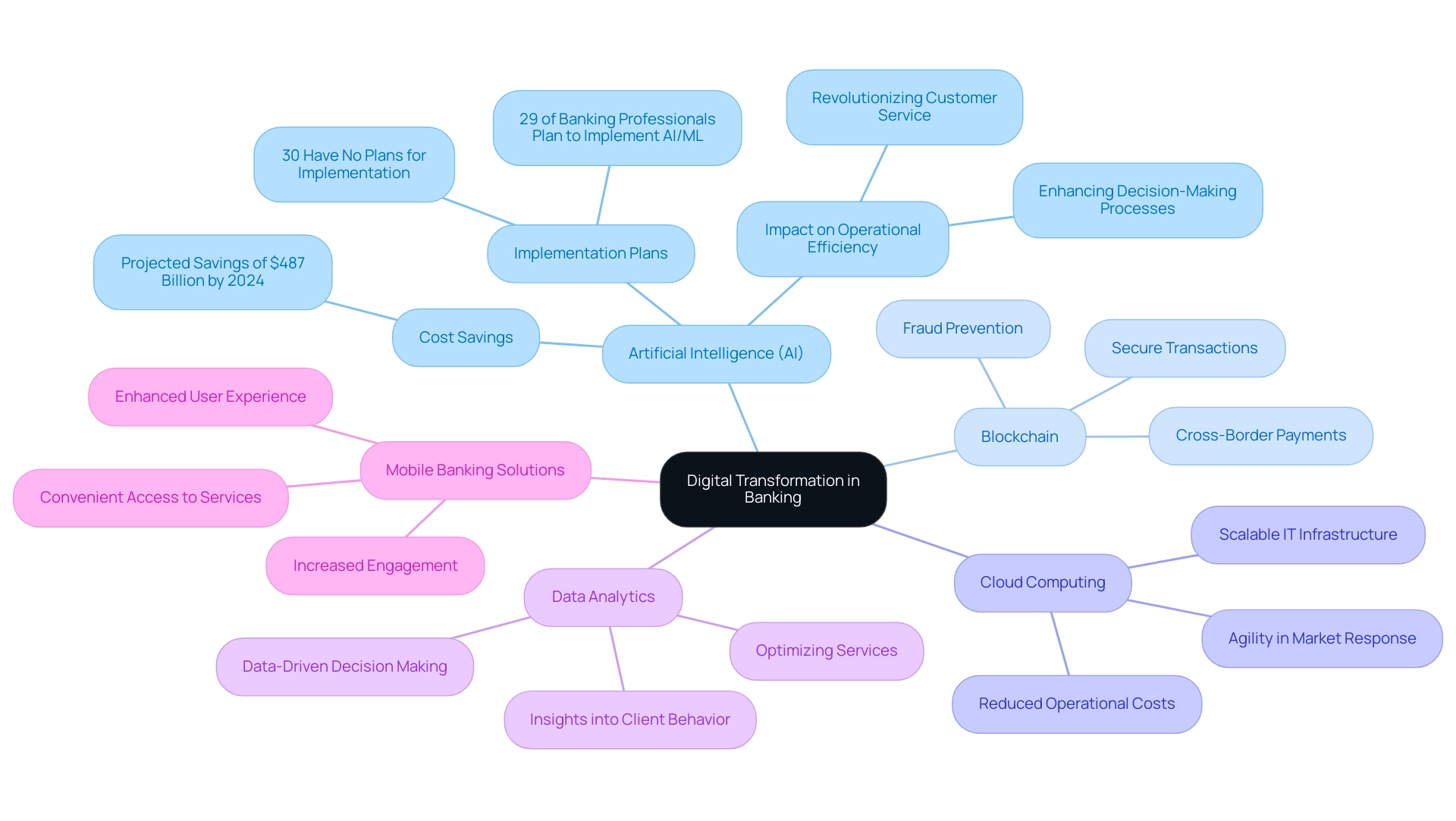
Challenges in Implementing Digital Transformation
Implementing digital banking transformation presents a myriad of challenges that institutions must navigate to remain competitive and secure. Key obstacles include:
- Legacy Systems: A significant number of banks continue to operate on outdated technology, complicating the integration of new systems. This reliance on legacy infrastructure incurs high costs and limits the agility needed to respond to market demands. Avato addresses these challenges by simplifying complex integrations and delivering cost-effective solutions that future-proof technology stacks. Statistics indicate that 20% of IT leaders attribute technology transformation failures to unclear or unsupportive leadership, highlighting the need for strategic direction in overcoming these technological barriers.
- Cultural Resistance: The transition to electronic solutions often encounters opposition from employees familiar with conventional processes. This cultural inertia can impede the adoption of innovative technologies, making it essential for leadership to foster a culture of change and continuous improvement. Engaging staff through training and clear communication about the benefits of transformation can mitigate this resistance. As Val Srinivas, a senior research leader in banking and capital markets, observes, “Leadership plays a crucial role in guiding organizations through the complexities of transformation, ensuring that teams are aligned and motivated to embrace change.” Mobilizing stakeholders to get requirements right the first time is crucial for overcoming resistance.
- Regulatory Compliance: The banking sector is heavily regulated, and integrating new technologies while adhering to compliance requirements can be daunting. Financial institutions must ensure that their digital initiatives align with regulatory standards, often necessitating additional resources and expertise to navigate the complexities involved. Avato’s solutions are designed for secure transactions, making them a reliable option for financial institutions, healthcare, and government sectors.
- Data Security: As banks increasingly digitize their operations, they face heightened risks of cyberattacks and data breaches. The necessity for strong security measures is crucial, as 71% of clients are more inclined to trust a company with their personal data if its use is clearly articulated. This underscores the importance of transparency and security in building customer trust during the transformation process. Avato’s hybrid integration platform accelerates secure system integration, ensuring that data security is prioritized throughout the transformation journey.
- Skill Gaps: The rapid evolution of technology demands a workforce proficient in new tools and systems. However, many banks struggle to find employees with the necessary skills, leading to a talent gap that can hinder technological initiatives. Investing in training and development programs is essential for equipping staff with the skills needed to excel in a technological environment. Avato supports organizations in modeling new business processes and activity flows, helping to bridge these skill gaps.
Tackling these challenges is essential for financial institutions seeking to effectively execute their digital banking transformation strategies. Case studies in the financial services sector, particularly in payments transformation, illustrate how institutions are rethinking their strategies to adapt to the ongoing digital banking transformation. The ongoing transformation in payments is expected to influence strategic imperatives for insurers and financial institutions as they rethink their strategies for the future.
By overcoming legacy systems and fostering a culture of innovation, banks can enhance client satisfaction and trust, positioning themselves competitively against emerging tech-driven financial services.
To learn more about how Avato can assist your organization in navigating these challenges, visit our FAQs or read testimonials from satisfied clients who have successfully transformed their operations with our solutions.
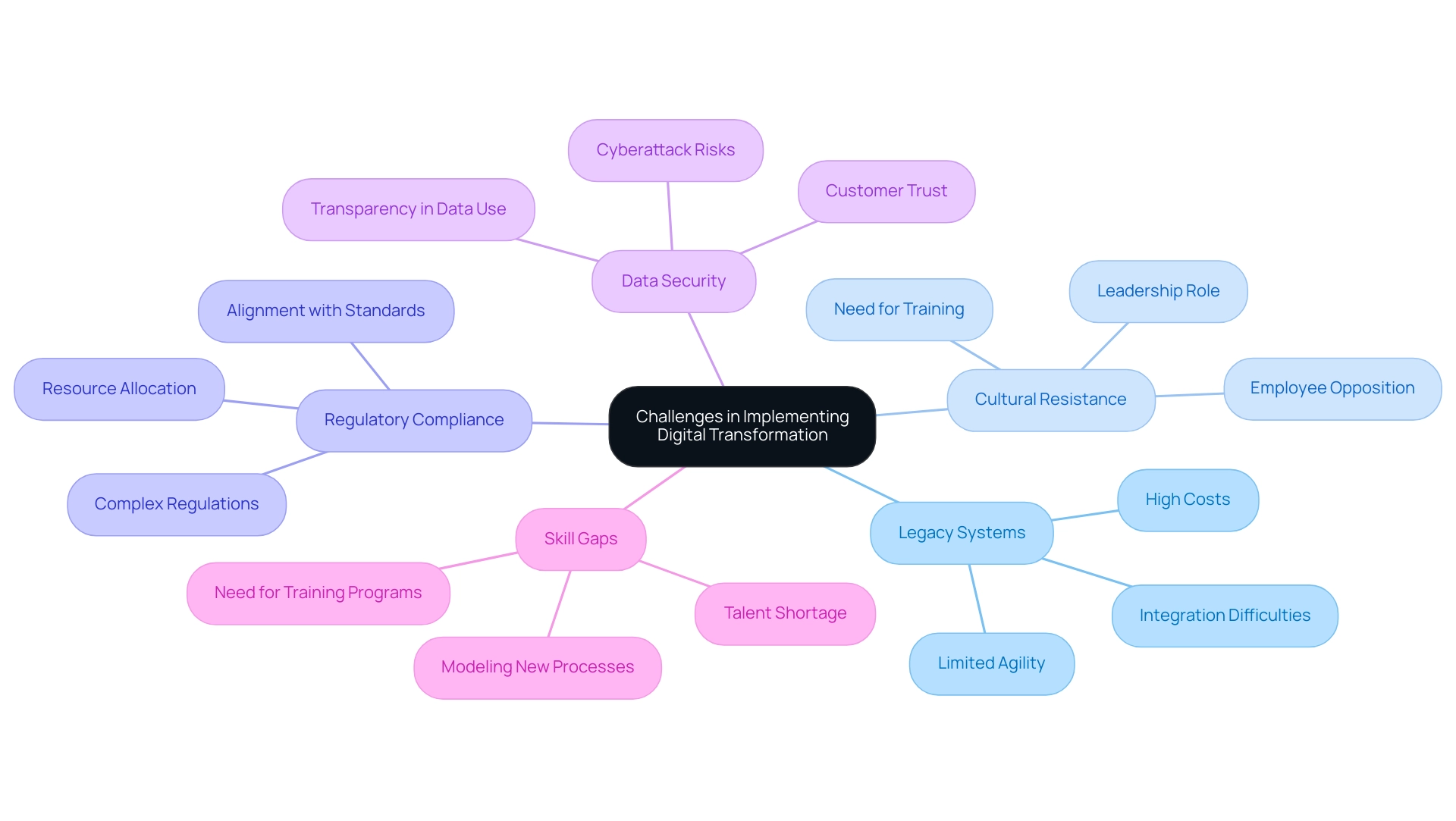
Effective Strategies for Successful Digital Transformation
To successfully navigate the complexities of digital transformation in banking, institutions must adopt strategic approaches that ensure alignment with their overarching objectives.
- Establish a Clear Vision: A well-defined digital strategy is crucial. This vision serves as a roadmap, guiding transformation efforts and ensuring that all initiatives are cohesive and purpose-driven.
- Foster a Culture of Innovation: Cultivating an environment that encourages change and experimentation is essential. By fostering a mindset that embraces innovation, financial institutions empower employees to contribute ideas and solutions that drive digital banking transformation.
- Invest in Training and Development: As technology evolves, so must the workforce. Providing staff with necessary training and development opportunities equips them to adapt to new technologies and processes, ultimately enhancing operational efficiency.
- Leverage Partnerships: Collaborating with fintech firms and technology providers unlocks access to cutting-edge solutions and expertise. The hybrid integration platform, supported by Red Hat technology, enables seamless data and systems integration, accelerating innovation and facilitating digital banking transformation. Avato also provides essential services in enterprise architecture, project management, and technical analysis for effective transformation.
- Prioritize Customer Experience: Designing services with the customer at the forefront is vital. Digital solutions should enhance user satisfaction and engagement, reflecting the growing expectation for seamless and personalized banking experiences.
The global online banking market is anticipated to reach $22.3 trillion by 2026, expanding at a compound annual growth rate (CAGR) of 8.5%. However, challenges persist, as studies indicate that only 30% of digital transformations fully succeed. The primary reasons for failure include a lack of employee engagement and resistance during implementation.
Successful digital banking transformation is more likely when financial institutions align their strategies, invest in the right technology, and effectively manage change, emphasizing the importance of employee involvement.
As Gustavo Estrada from BC Provincial Health Services Authority notes, “This solution has the ability to simplify complex projects and deliver results within desired time frames and budget constraints.” This underscores the importance of a strong integration platform that facilitates these strategies, ultimately allowing financial institutions to overcome challenges such as the 26% of senior executives who cite high expenses as a significant hindrance to achieving digital banking transformation. By aligning their digital banking transformation initiatives with a clear vision and investing in the appropriate technology, including Avato’s comprehensive hybrid integration services, financial institutions can enhance operations and meet client expectations more effectively.
- Get your copy now
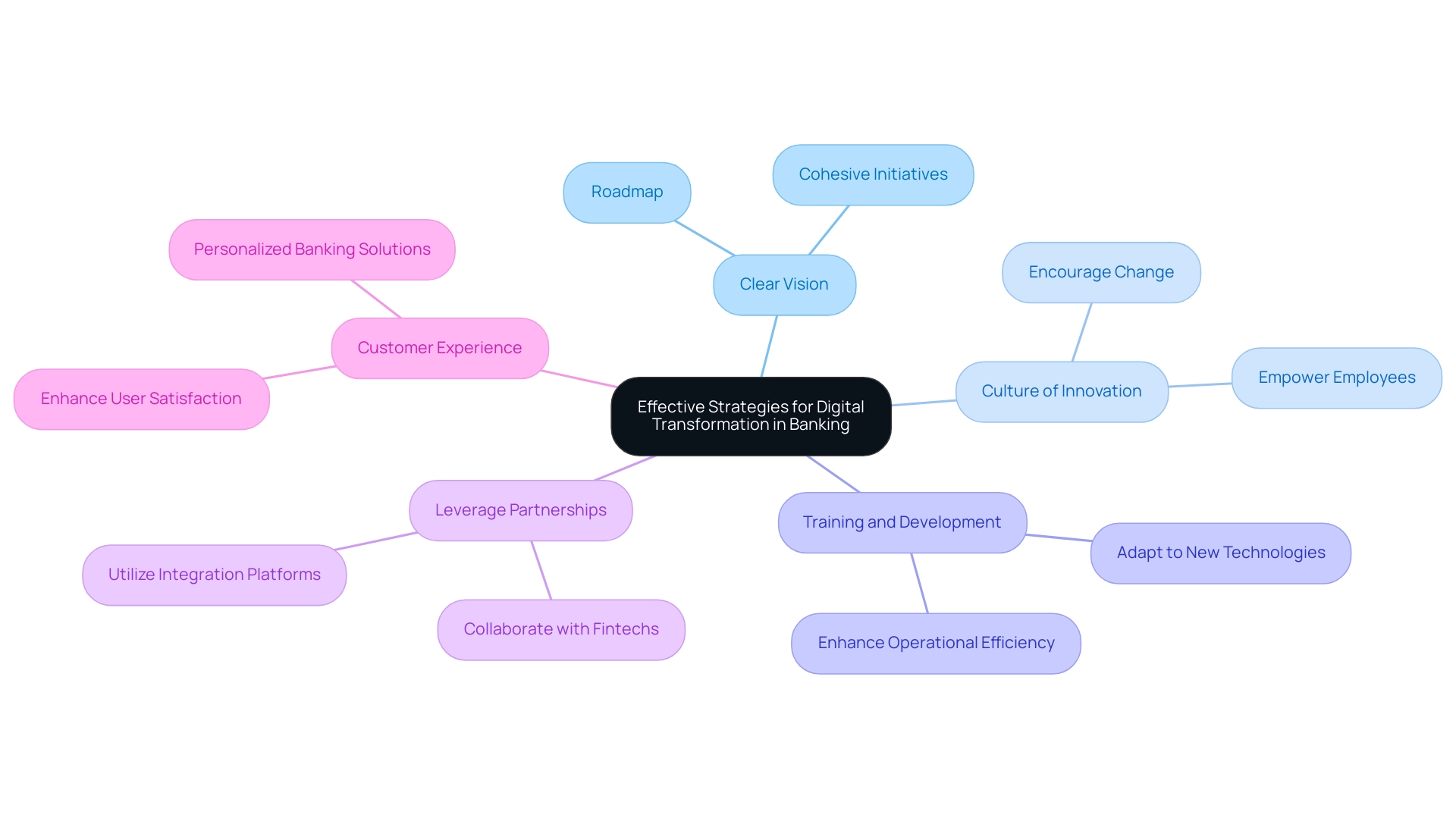
Enhancing Customer Experience Through Digital Transformation
Digital transformation presents banks with a unique opportunity to significantly elevate customer experience through several key strategies:
- Personalization: Utilizing data analytics allows banks to tailor services and communications to address the specific needs and preferences of individual clients. As Esat, Product Marketing Manager, observes, ‘Personalization isn’t merely a trend, it’s a fundamental change in how successful businesses engage with their clients.’ This approach not only enhances satisfaction but also fosters loyalty, as individuals are willing to spend 38% more with brands that excel in personalization. The integration of generative AI further enhances this capability, allowing for the development of sophisticated chatbots and virtual assistants that provide tailored interactions. Significantly, there has been a 60% rise in the use of generative AI for user experience, emphasizing its importance in digital banking transformation.
- Omni-channel Experiences: Providing seamless interactions across various channels—such as mobile apps, online platforms, and in-branch services—ensures that individuals can engage with their bank in a manner that suits them best. This trend is increasingly vital as clients expect consistent and integrated experiences regardless of the channel they choose. Avato’s hybrid integration platform supports this by enabling secure and efficient system integration across various channels, enhancing the overall client journey.
- Faster Service Delivery: By automating processes, financial institutions can significantly reduce wait times and improve overall service efficiency. This not only improves client satisfaction but also enables financial institutions to distribute resources more efficiently, ultimately resulting in superior service outcomes. The use of generative AI for document processing and report generation streamlines operations, contributing to faster service delivery.
- Improved Protection: Implementing advanced security measures is crucial for establishing user trust in online services. As cyber threats keep advancing, financial institutions must prioritize strong security measures to safeguard sensitive client information and uphold trust in their digital services. Avato is designed for secure transactions, making it a reliable partner for financial institutions aiming to enhance their security posture. As Tony Leblanc from the Provincial Health Services Authority states, “Good team. Good people to work with. Extremely professional. Extremely knowledgeable.”
- Feedback Mechanisms: Establishing effective channels for client feedback is essential for continuous improvement. By actively seeking feedback from clients, banks can identify pain points and make necessary adjustments to enhance their services. For instance, proactive client support—such as reaching out with helpful tips and alerts—can strengthen relationships and demonstrate genuine care, fostering trust-based connections. This approach not only enhances customer relationships but also aligns with the importance of customer retention in banking, as focusing on existing customers can save costs and grow revenues.
Incorporating these strategies not only aligns with the latest trends in digital banking transformation for 2025 but also positions banks to thrive in an increasingly competitive landscape. Ongoing innovation and assessment of outcomes will foster greater loyalty and a more robust brand presence in the market, backed by capabilities in simplifying complex integrations and providing cost-effective solutions. Avato’s support for 12 levels of interface maturity further emphasizes the sophistication and adaptability of its solutions.
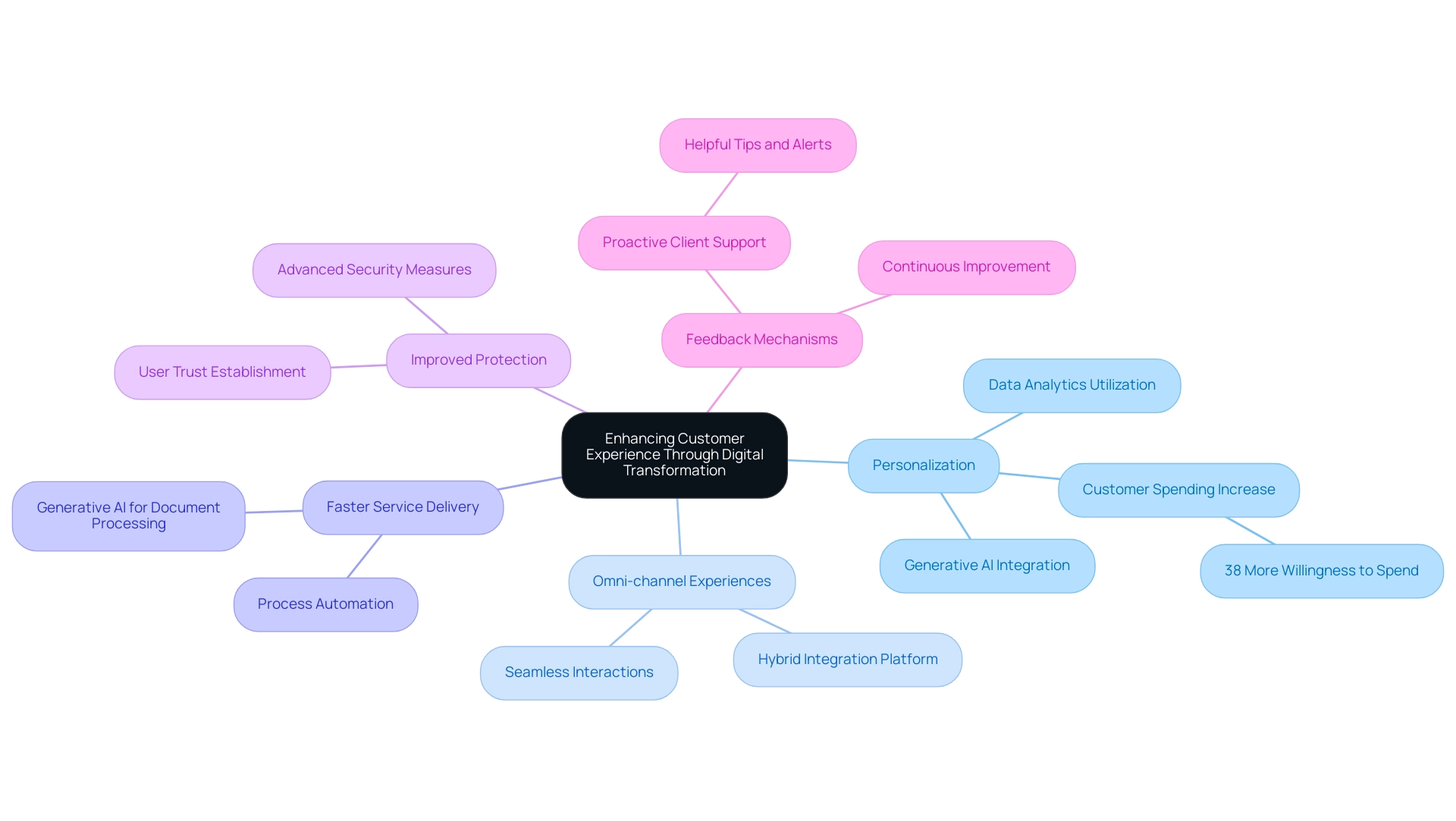
Leveraging Data and Analytics in Digital Banking
Data and analytics are pivotal in driving digital transformation, empowering financial institutions to achieve several key objectives:
-
Understand Client Behavior: Leveraging advanced analytics, banks can delve into client data to uncover trends and preferences. This insight allows for precise targeting in marketing strategies and service offerings, ultimately enhancing satisfaction and loyalty. The Hybrid Integration Platform supports digital banking transformation by ensuring seamless integration of diverse data sources, facilitating a comprehensive view of customer interactions.
-
Improve Risk Management: The integration of sophisticated analytics tools significantly enhances fraud detection and risk assessment capabilities. By analyzing patterns and anomalies in real-time, financial institutions can make informed decisions that mitigate risks and bolster security measures. The Hybrid Integration Platform ensures these analytics are supported by secure and reliable connections, crucial for maintaining data integrity, along with real-time monitoring and alerts to promptly address any issues.
-
Optimize Operations: Data-driven insights streamline banking processes, leading to reduced operational costs and improved efficiency. The company guarantees round-the-clock availability for crucial integrations, which is vital as financial institutions aim to remain competitive in the digital banking transformation era within an increasingly digital environment. By simplifying complex integrations, Avato maximizes the value of legacy systems, allowing financial institutions to leverage existing assets while minimizing costs.
-
Enhance Product Development: Understanding client needs through data analytics enables financial institutions to innovate and create products that align with market demands. This responsiveness not only meets customer expectations but also positions banks as leaders in product offerings. As noted by Gustavo Estrada, the company simplifies complex projects and delivers results within desired time frames and budget constraints, essential for effective product development. This capability is further enhanced by Avato’s integration solutions that facilitate collaboration across teams and systems.
-
Facilitate Regulatory Compliance: In the ever-evolving regulatory landscape, data analytics plays a vital role in helping financial institutions monitor compliance effectively. By identifying potential issues early, banks can proactively address them, ensuring adherence to regulations and minimizing the risk of penalties. The organization’s dedication to regulatory compliance and security evaluations further enhances its integration solutions, providing reassurance for financial institutions.
As we look toward 2025, the significance of client behavior analysis in the realm of digital banking transformation will only increase. Trends indicate a shift towards increased personalization, omnichannel engagement, and a focus on privacy and data ethics. The retail market expansion propelled by online shopping demonstrates the rising demand for analytical tools, as businesses aim to utilize consumer data for enhanced insights and tailored experiences.
Banks that harness the power of data analytics, supported by Avato’s efficient hybrid integration, will be better prepared to navigate these changes, ensuring they meet the evolving expectations of their clients while maintaining a competitive advantage in the financial services sector.
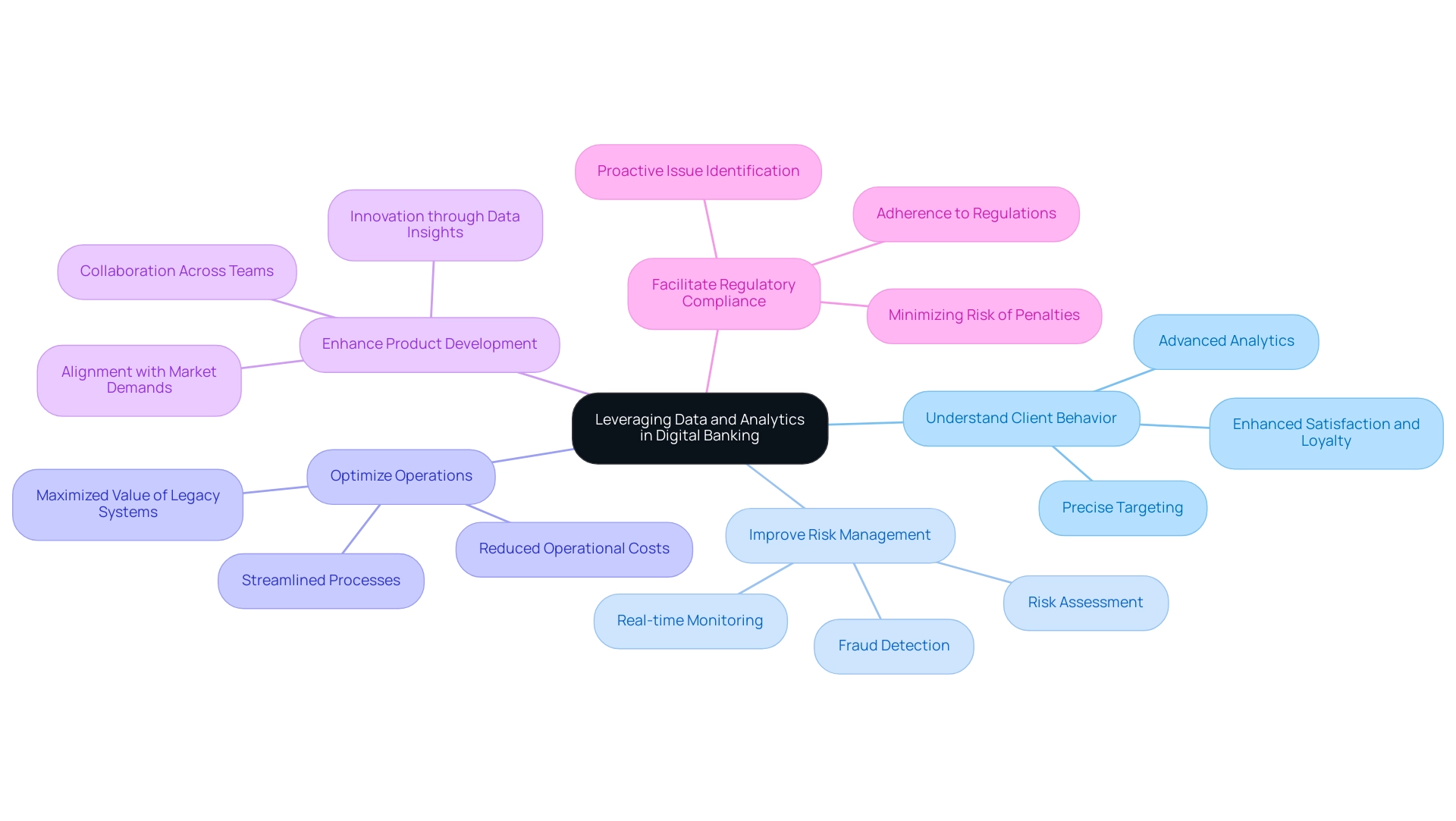
Case Studies: Successful Digital Transformation in Banking
Many financial institutions have made considerable progress in their digital banking transformation initiatives, demonstrating creative strategies that have resulted in improved client experiences and operational efficiencies. Notable examples include:
- Bank of America: By investing heavily in artificial intelligence and machine learning, Bank of America has transformed its mobile banking application. This investment has allowed the bank to provide tailored financial guidance, thereby significantly enhancing client engagement and satisfaction.
- BBVA: This institution has embraced a data-driven strategy, utilizing advanced analytics to refine client interactions and streamline its operations. The result has been a marked increase in customer satisfaction, demonstrating the power of data in enhancing service delivery.
- ING: With a strong emphasis on agile methodologies, ING has been able to rapidly develop and launch new online products. This approach has greatly enhanced the institution’s responsiveness to market changes, allowing it to stay ahead of competitors in a fast-evolving landscape.
- Wells Fargo: By integrating blockchain technology into its operations, Wells Fargo has enhanced the efficiency and security of its cross-border payment processes. This innovation not only reduces transaction times but also bolsters trust among customers.
- HSBC: Leveraging cloud computing has allowed HSBC to increase its operational flexibility. This shift has resulted in faster service delivery and enhanced client experiences, showcasing the benefits of modern technology in banking.
As digital banking transformation accelerates, it is crucial for banks to adapt to these changes. A recent survey indicated that generative AI is now the second-most-used AI workload in financial services, with a 60% increase in its application for user experience through sophisticated chatbots and virtual assistants. This underscores the transformative effect of AI on client engagement and operational efficiency.
Furthermore, over half of financial professionals are utilizing generative AI for document processing and report generation, streamlining operations and enhancing productivity across various departments. Industry leaders like Sriram Natarajan emphasize the importance of leveraging AI and process transformation to enhance efficiency and customer experiences, underscoring the ongoing evolution within banking and financial services. Additionally, as digital banking transformation accelerates, the challenge of skill shortages remains a significant concern for CEOs, further complicating the implementation of these initiatives.
To navigate these challenges, financial institutions must ensure a reliable, future-proof technology stack that allows them to adapt to changing demands. This entity plays a pivotal role in this landscape, delivering a connected foundation that simplifies complex integrations and supports secure transactions, making it an essential partner for banks aiming to modernize their operations. The platform’s capabilities, including support for 12 levels of interface maturity, enable institutions to balance speed of integration with the sophistication required to future-proof their technology stack. As noted by Tony Leblanc from the Provincial Health Services Authority, Avato is recognized for its professionalism and knowledge, further solidifying its reputation as a trusted partner in the financial services sector.
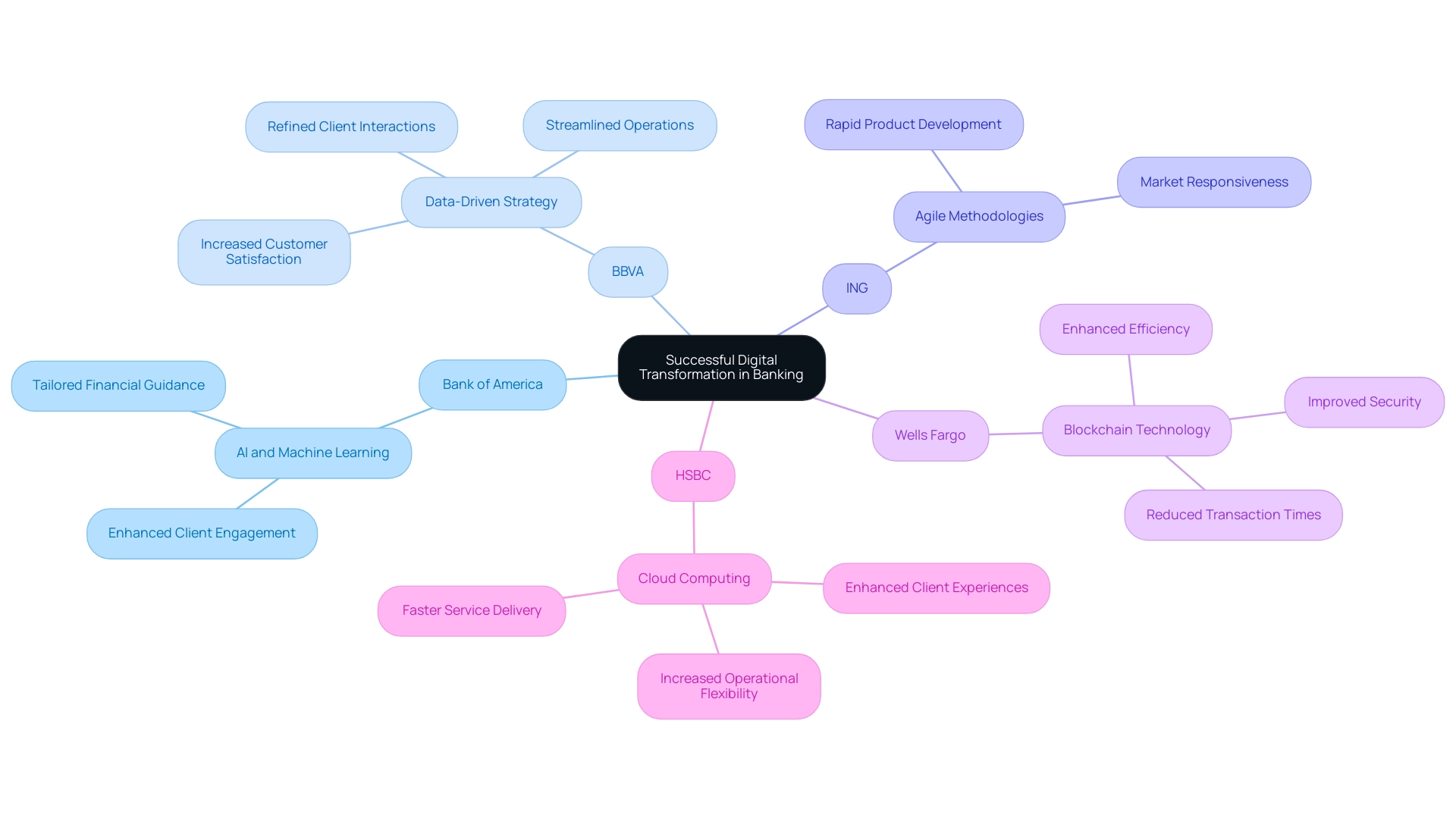
Future Trends in Digital Banking Transformation
As digital banking transformation evolves, several key trends are poised to shape its future landscape.
- Heightened Adoption of AI: By 2030, all financial institutions are expected to utilize generative AI for application development, significantly enhancing personalization in client experiences and optimizing operational processes. This shift will empower financial institutions to offer tailored services that effectively meet individual customer needs.
The NVIDIA 2025 State of AI in Financial Services survey highlights that the time to act is now. Avato’s hybrid integration solutions enable financial institutions to lead this AI revolution, ensuring seamless integration of AI capabilities into their operations.
-
Open Banking: The emergence of open banking is transforming the financial industry by fostering cooperation between traditional institutions and FinTech firms. This partnership will lead to the creation of innovative financial products and services, enhancing customer choice and driving competition. Avato’s platform supports this integration, allowing financial institutions to connect effortlessly with various partners.
-
Sustainability Initiatives: With increasing awareness of environmental issues, financial institutions are prioritizing sustainability. Integrating eco-friendly practices into their operations aligns with consumer expectations and positions institutions as responsible corporate citizens, enhancing their reputation and customer loyalty. Avato’s solutions assist banks in modeling their processes to incorporate sustainability effectively.
-
Enhanced Cybersecurity Measures: As online banking expands, so do the risks associated with cyber threats. Financial institutions are expected to invest significantly in advanced security technologies to safeguard customer data and maintain trust. A recent case study indicates that these investments are projected to grow, enhancing the security of banking operations against evolving threats. The company supports banks in their digital transformation by future-proofing systems and ensuring robust cybersecurity measures are incorporated into their strategies.
-
Integration of Digital Assets: The adoption of cryptocurrencies and digital assets is reshaping banking services. Banks must adapt their strategies to incorporate these new financial instruments, ensuring relevance in a rapidly changing market. This trend presents both challenges and opportunities for innovation in service delivery. The hybrid integration platform provides the necessary tools to navigate these changes and optimize integration strategies effectively.
These trends underscore the necessity of integrating risk and compliance into digital banking transformation initiatives, leading to sustainable cost reductions and mitigating regulatory risks. As Vikram (Vik) Bhat, Vice Chair and US Financial Services Industry Leader, emphasizes, fostering an inclusive environment that nurtures talent is crucial for navigating these changes effectively. This approach is essential for financial institutions to address the five critical questions for executives highlighted in a recent report, particularly regarding sustainable growth in the finance industry.
By prioritizing these strategies and leveraging Avato’s solutions, banks can position themselves for success in the evolving digital landscape. Don’t wait! Connect with Avato today to explore your evolving AI needs.
Our AI assessment is designed to provide tailored insights and strategies to elevate your business. Let’s discover how we can help you thrive in the AI landscape!
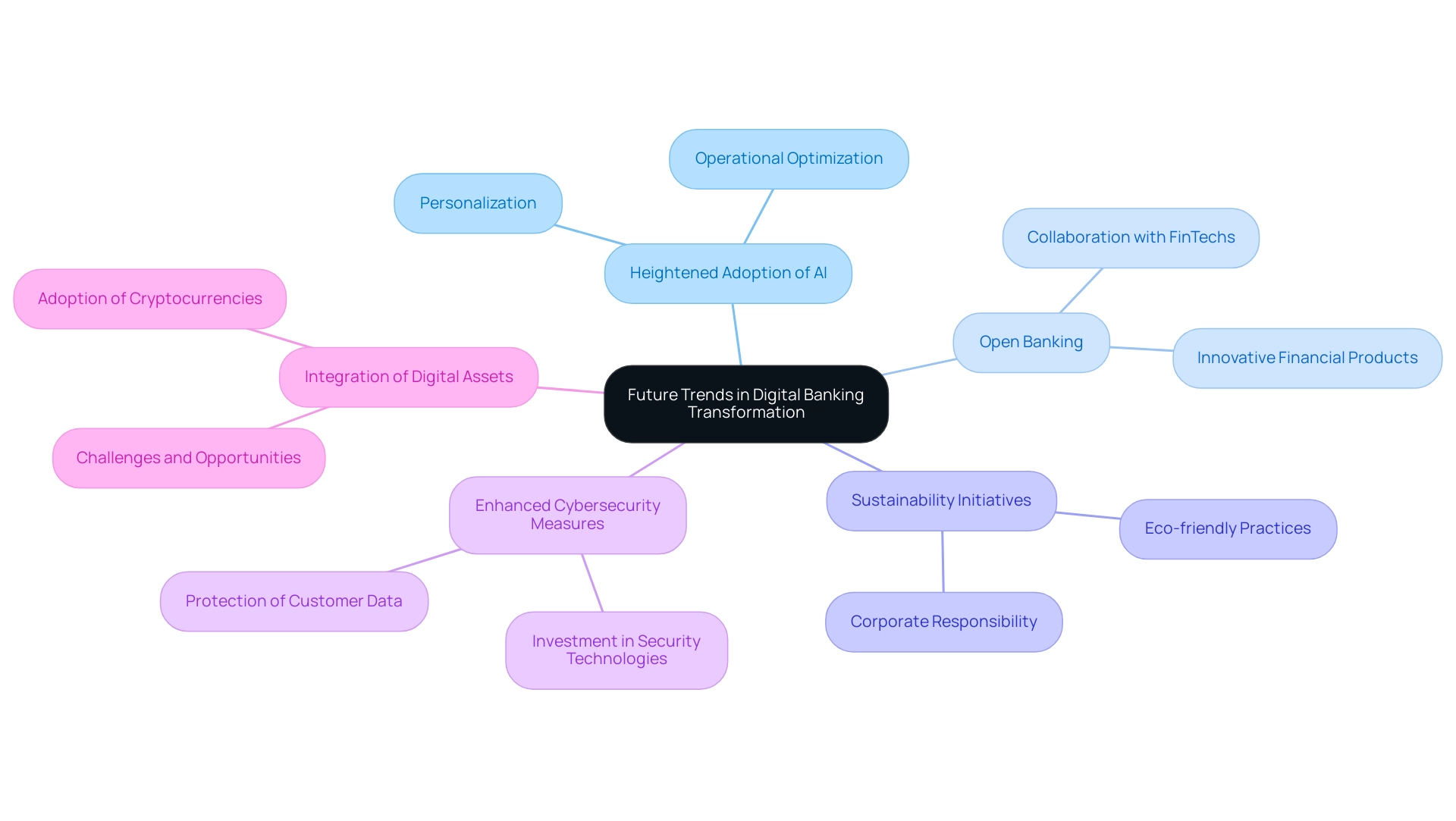
Conclusion
Digital banking transformation transcends a mere technological shift; it embodies a fundamental change in how banks operate and engage with their customers. By embracing digital technologies, financial institutions can significantly enhance customer experiences and operational efficiencies while deftly navigating the complexities of legacy systems and regulatory requirements. The adoption of AI, blockchain, cloud computing, and data analytics stands as a testament to the industry’s unwavering commitment to innovation and customer empowerment.
Despite the formidable challenges posed by outdated infrastructures, cultural resistance, and skill gaps, banks that prioritize a clear vision and cultivate a culture of innovation will be strategically positioned to thrive in this evolving landscape. Successful case studies from leading banks illustrate that a strategic approach to digital transformation can lead to remarkable improvements in customer satisfaction and financial performance. The future of banking is poised for further advancements, with trends such as open banking, sustainability initiatives, and enhanced cybersecurity measures shaping the way forward.
Ultimately, the integration of advanced technologies and a steadfast commitment to fostering a customer-centric environment will be critical for financial institutions aiming to maintain their competitive edge. As the digital banking landscape continues to evolve, partnering with innovative solutions like Avato can provide the necessary support to navigate these changes effectively. By leveraging the right tools and strategies, banks can not only meet but exceed the expectations of their customers, paving the way for a successful and sustainable future in finance.

